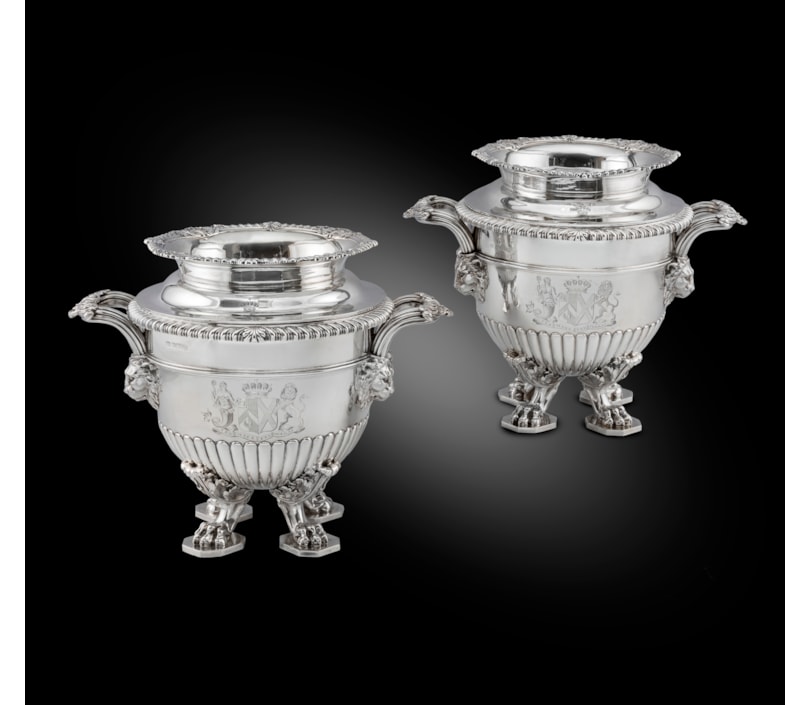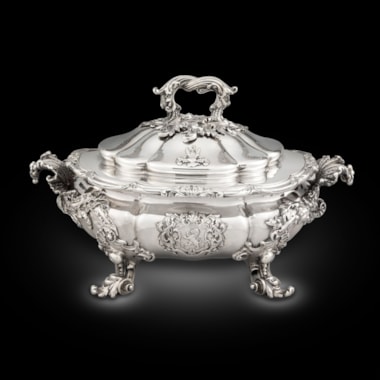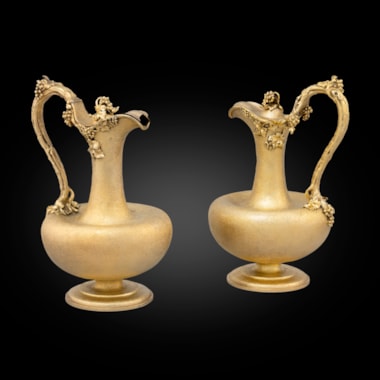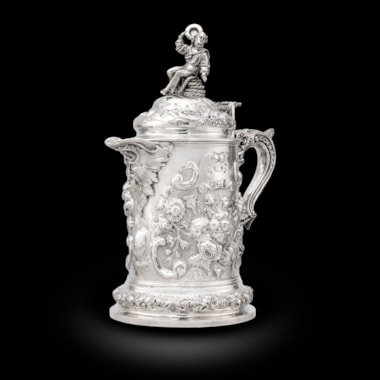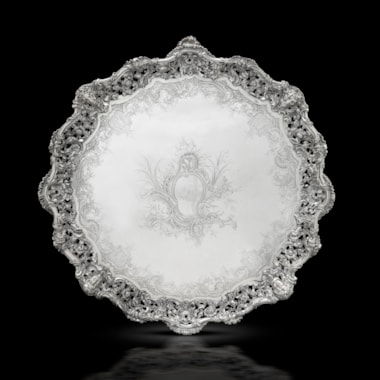Of urn shape with detachable upper ring and interior liner, the upper ring with a gadrooned and floral decoration, the body with two scrolled handles terminating in lion's head mounts and a gadroon-decorated rim, the lower body with a wide gadroon pattern and standing on paw feet attached with acanthus decorations. Each with a coat of arms with a lion and mermaid engraved, "PER MARE PER TERRAS"
Du Pré Alexander, 2nd Earl of Caledon KP (14 December 1777 – 8 April 1839), styled The Honourable Du Pré Alexander from 1790 to 1800 and Viscount Alexander from 1800 to 1802, was an Irish peer, landlord and colonial administrator, and was the second child and only son of James Alexander, 1st Earl of Caledon
He was educated from 1790 to 1796 at Eton College in England and later at Christ Church, Oxford. He was elected Member of Parliament for Newtownards in 1800 and sat in the Irish House of Commons until the Act of Union in 1801. In the latter year, he was appointed High Sheriff of Armagh.[1] He succeeded to the title of Earl of Caledon on the death of his father in 1802 and was elected a Representative Peer for Ireland in 1804.
In July 1806 he was appointed Governor of the Cape of Good Hope in what is now South Africa. He was the first governor on the Cape's cession to United Kingdom; the Caledon River and the district Caledon, Western Cape there are named after him. Lord Caledon was not, literally, the first British civil governor of the Cape, having been preceded in that capacity by Lord Macartney and Sir George Yonge, successive holders of the office between the first conquest of the Cape, and its cession back to the Dutch under the terms of the Peace of Amiens of 1802. Rather, Lord Caledon was the first civil governor after the Cape's reconquest from the Dutch by General Sir David Baird in 1806. The question of the relationship between the civil and the military authorities of the colony, personified in Lord Caledon's relationship with the Commander-in-Chief, General Sir Henry Grey, was the most troublesome of the former's period of office as governor, and the issue on which he resigned in June 1811.
Less than three years after his departure, in March 1814, an open letter was written defending his record as governor. The writer, Colonel Christopher Bird, Deputy Colonial Secretary at the Cape (subsequently Colonial Secretary), was well qualified to speak, although his partisanship on Lord Caledon's behalf is unconcealed. In another part of the Caledon Papers, Lord Caledon's own appraisal of his governorship of the Cape is to be found. It occurs in the course of a letter which he wrote to the Prime Minister, the 2nd Earl of Liverpool, in 1818 stating his claims to be given a peerage of the United Kingdom: '... The administration of the colonial government during my residence there for a term of four years, was more than usually arduous, in consequence of my being the first civil governor after the capture of the settlement, and from there being no records of a former British government in any of the public offices at The Cape. ... I hope I shall be excused for stating that, upon my own responsibility and under the most embarrassing circumstances, occasioned by the loss of four British frigates which were to have protected the convoy, I detached 2,000 infantry to co-operate with the force from India in the reduction of the Mauritius. In a letter from Lord Minto [Governor General of India] upon that occasion, he acknowledges the public service I rendered, not only as relating to the fall of the Mauritius, but adds that it was to the co-operation I afforded he was indebted for the means of moving against Java. ...'.[2]
Lord Caledon married Lady Catherine Yorke, daughter of Philip Yorke, 3rd Earl of Hardwicke and Lady Elizabeth Lindsay, on 16 October 1811 in St. James' Church, Westminster, and had issue:
James Du Pre Alexander, 3rd Earl of Caledon (27 July 1812 – 30 June 1855)
With this marriage the Caledon family effectively inherited Tyttenhanger House near St Albans, Hertfordshire, which had belonged to the 3rd Earl of Hardwicke's grandmother, Katherine Freeman, the sister and heiress of Sir Henry Pope Blount, 3rd and last Baronet.[2] Sir Henry died in 1757 without issue, leaving his sister Katherine, the wife of Rev. William Freeman, his heir. She left an only daughter, Catherine, who married Charles Yorke, second son of Philip Yorke, 1st Earl of Hardwicke, whose son Philip, 3rd Earl of Hardwicke, on his death in 1834, left four daughters, to the second of whom, Catherine, the wife of the 2nd Earl of Caledon, came the manor of Tyttenhanger.
Lord Caledon was invested as a Knight of St Patrick on 20 August 1821 and was appointed Lord Lieutenant of County Tyrone in 1831. He died on 8 April 1839 at Caledon, aged 61, much mourned by his tenants in the model town of Caledon, which he had rebuilt and enlarged so sympathetically. A loyal address from the tenantry issued a few years earlier alludes to his 'acts of liberality, munificence and kindness' and there is plenty of evidence to confirm that this was no mere empty elegy. 'Lord Caledon', wrote Inglis in his book Ireland (1834), 'is all that could be desire – a really good resident country gentleman'.[3]
Lady Caledon died on 8 July 1863, having bequeathed Tyttenhanger to her daughter-in-law Jane, with an entail upon her four children and, according to one source, the estate descended to her eldest son James Alexander, 4th Earl of Caledon, who died in 1898. His widow became lady of the manor and held it in trust for her children.[4] Other sources indicate that Tyttenhanger was the home of Lady Jane Van Koughnet, the daughter of the 4th Earl of Caledon, and her husband, Commander E. B. Van Koughnet, until her death in 1941.[5] The house was sold in 1973.
Stuart, John (1819). Historical Memoirs of The City of Armagh. Newry: Alexander Wilkinson. p. 557.
Summary of the Caledon Papers, Public Record Office of Northern Ireland, A. P. W. Malcomson
Great Houses of Ireland, Hugh Montgomery-Massingberd and Christopher Simon Sykes (Laurence King, London 1999)
A History of the County of Hertford: volume 2, 1908, found at http://www.british-history.ac.uk/report.asp?compid=43299
Hertfordshire County Homes, found at http://www.hertfordshire-genealogy.co.uk/data/books/books-3/book-0325-herts-county-homes.htm
Son of Thomas Storr of Westminster, first silver-chaser later innkeeper, born 1771. Apprenticed c'1785. Before his first partnership with William Frisbee in 1792 he worked at Church Street, Soho, which was the address of Andrew Fogelberg. This is also the address at which Storr's first separate mark is also entered. First mark entered as plateworker, in partnership with William Frisbee, 2 May 1792. Address: 5 Cock Lane, Snow Hill. Second mark alone, 12 January 1793. Address: 30 Church Street, Soho. Third mark, 27 April 1793. Fourth 8 August 1794. Moved to 20 Air Street, 8 October 1796, (where Thomas Pitts had worked till 1793). Fifth mark, 29 November 1799. Sixth, 21 August 1807. Address 53 Dean Street, Soho. Seventh, 10 February 1808. Ninth, 21 October 1813. Tenth, 12 September 1817. Moved to Harrison Street, Gray's Inn Road, 4 March 1819, after severing his connection with Rundell, Bridge and Rundell. Eleventh mark, 2 September 1883. Address: 17 Harrison Street. Twelfth and last mark, 2 September 1833. Heal records him in partnership with Frisbee and alone at Cock Lane in 1792, and at the other addresses and dates above, except Harrison Street. Storr married in 1801, Elizabeth Susanna Beyer of the Saxon family of piano and organ builders of Compton Street, by whom he had ten children. He retired in 1838, to live in Hill House in Tooting. He died 18 March 1844 and is buried in Tooting Churchyard. His will, proved 3 April 1844, shows an estate of £3000. A memorial to him in Otely Church, Suffolk was put up by his son Francis the then incumbent of the parish. For full details of Storr's relationship with Rundell, Bridge and Rundell please see N.M. Penzer, 1954 or Royal Goldsmiths, The Art of Rundell and Bridge, 2005.
Storr's reputation rests on his mastery of the grandoise neo-Classical style developed in the Regency period. His early pieces up to about 1800 show restrained taste, although by 1797 he had produced the remarkable gold font for the Duke of Portland. Here, however the modelling of the classical figures must presumably have been the work of a professional sculptor, as yet unidentified, and many of the pieces produced by him for Rundell and Bridge in the Royal Collection must have sprung from designs commissioned by that firm rather than from his own invention. On the other hand, they still existed in his Harrison Street workshop, until destroyed in World War II, a group of Piranesi engravings of classical vases and monuments bearing his signature, presumably used as source material for designs. The massiveness of the best of his compositions is well shown in the fine urn of 1800 at Woborn Abbey, but the Theocritus Cup in the Royal Collection must be essentially ascribed to the restraint of its designer John Flaxman, while not denying to Storr its superb execution. Lord Spencer's ice pails of 1817 show similar quality. Not all Storr's work however was of classical inspiration. The candelabra of 1807 at Woburn derive from candlesticks by Paul Crespin of the George II period, formerly part of the Bedford Collection, and he attempted essays in floral rococo design from time to time, which tend to over-floridity. On occasions the excellence of his technical qualities was marred by a lack of good proportions, as in the chalices of the church plate of St Pancras, 1821. In spite of these small lapses there is no doubt that Storr rose to the demands made upon him as the author of more fine display plate than any other English goldsmith, including Paul De Lamerie, was ever called upon to produce.
You May Also Like



































































